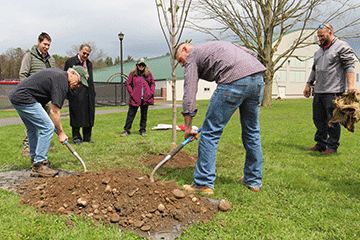Every day is Arbor Day for this Red Dragon
04/29/2022

In celebration of Arbor Day, SUNY Cortland on Monday planted two Red Chestnut trees near Lusk Field House, adding a new tree species to the 39 already on campus.
That's impressive, and worthy of Cortland's recognition as a Tree Campus USA.
But Melinda Clancy ’13 won't be outdone. She intends to plant nearly 20,000 trees across all five boroughs of New York City.
“I get to celebrate Arbor Day every day,” joked Clancy, a procurement forester for the New York City Department of Parks and Recreation. She hand-selected 9,000 to 10,000 trees of different species for the environmentally diverse urban landscape to plant this spring and plans to do a similar number this fall.
“It’s a lot of trees,” the former SUNY Cortland biology major acknowledged. “But I love it. It’s an amazing job, and I love to do it and I am so grateful to have it.”
Clancy recently talked about her role in greening the Big Apple in a profile published in The New York Times. She said the first thing she did after reading it online was share it with SUNY Distinguished Teaching Professor Steven Broyles, a Cortland educator who she credits with setting her on her current, tree-lined career path.
“She comes to her observations with a creative eye, and I think she often saw things the rest of us didn’t see,” Broyles said of his former student. “She’s worked her way up through the ranks in New York City. The fact that she’s come so far and has a very respected job with authority is exciting.”
A self-described “tree nerd,” Clancy grew up on seven acres of wooded mountainside in Putnam County, about 50 miles from New York City. She developed a love of nature at an early age. That interest initially became a desire to become a biology teacher, which led her to SUNY Cortland.
“Cortland has a great biology program, and I loved the Cortland campus,” she said.
The university grounds contain roughly 1,500 trees. Under Broyles’ tutelage, Clancy and other students used a computer program to digitally analyze SUNY Cortland’s tree canopy and assess the impact its trees have on storm water retention, air pollution and other environmental problems.
That tree inventory was the first step in SUNY Cortland’s successful application to be named a Tree Campus USA, which initiated the university’s annual Arbor Day tree planting ceremony.
“Although she had graduated before we started the Arbor Day ceremony, you can say that, as part of the group of students involved in the inventory, Melinda was instrumental in starting it,” Broyles said.
Although Arbor Day was officially Friday, April 29, this year, SUNY Cortland held its 2022 Arbor Day tree planting on Monday, May 2, to avoid a conflict with Transformations, the university’s annual celebration of student research and creativity. The Red Chestnuts were planted along a walkway between Lusk Field House and Park Center. The newly planted trees will become part of SUNY Cortland’s Tree Walk.
As an undergraduate research assistant working with Broyles and SUNY Distinguished Teaching Professor Emeritus Lawrence Klotz, Clancy researched old growth forest in the Hoxie Gorge Nature Preserve at William H. Parks Family Center for Environmental and Outdoor education. As part of the survey, Clancy identified and tagged different species in the university-owned forest about seven miles from campus.
“I think some of my tags are still there, from what I’ve heard,” Clancy said. “I learned my tree species and that really got my foot in the door toward my current position.”
Her Cortland education also took her to the Adirondack wilderness at the university’s William H. Parks Family Center for Environmental and Outdoor Education at Raquette Lake. She immediately fell in love with the environment.

“Once you go there, you understand what people say about it. You see the size of it,” she said. “I love it. I rent the lean-to at Camp Marian, across the water from Antlers, every year for my birthday. I just bring my friends and we canoe and swim and float. I’m a big swimmer. And there are hiking trails if you want to do that.”
But perhaps the most important boost to her forestry career came in the final semester of her senior year when she landed an internship collecting data on street tree mortality for a study conducted by New York City parks and recreation. She learned which species thrived, and which didn’t, in different urban environments and analyzed the factors that influenced it.
The internship led to a position as a street tree forester, managing and maintaining trees in city parks and along public sidewalks. A little more than four years ago, a coveted opening as a tree procurer opened up and Clancy jumped at it.
In that role, she visits tree nurseries on Long Island and in Maryland several times a year and selects a wide variety of tree species to build an inventory to fit all of the city landscapes’ unique conditions. Staten Island needs salt-resistant trees. Brooklyn needs shorter trees to accommodate overhead utility lines. Neighborhoods greatly impacted by heat need large-canopy shade trees.
She also considers the growing impact of climate change, buying more trees from warmer climates and increasing the speed of planting as the period of cold weather when trees go dormant and can be relocated gradually shrinks.
Clancy assesses each situation, selects from her tree inventory and travels to sites. Then she commutes an hour back to her home community in Putnam County, where she still lives.
“Basically, my office is my car,” Clancy said.